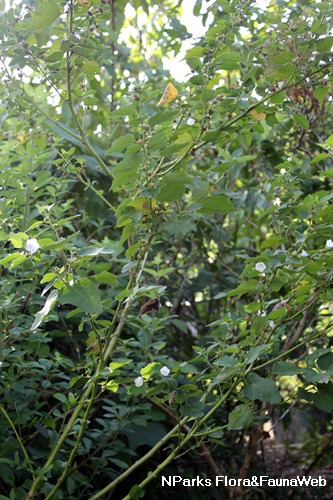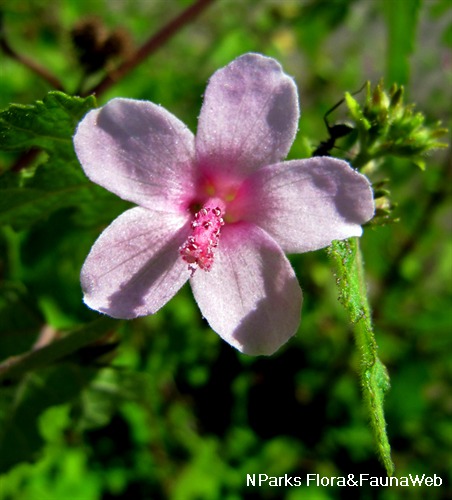
Name
Classifications and Characteristics
| Plant Division | Angiosperms (Flowering Seed Plants) |
|---|---|
| Plant Growth Form | Shrub |
| Lifespan (in Singapore) | Perennial |
| Mode of Nutrition | Autotrophic |
| Maximum Height | 0.8 m |
Biogeography
| Native Distribution | China, Taiwan |
|---|---|
| Native Habitat | Terrestrial |
| Local Conservation Status | Non-native (Horticultural / Cultivated Only) |
Description and Ethnobotany
| Growth Form | Subshrub (a low shrub with a woody stem and herbaceous stem tips) up to 0.8 m tall. |
|---|---|
| Foliage | Heart-shaped to triangular leaves (1-7 cm long, 1-4 cm wide) have 3 to 5 angular to obovate lobes. Both sides of the leaf are hirsute (covered in stiff, thick hairs) or tomentose (covered in soft, matted hairs). |
| Flowers | Small, hibiscus-like flowers are pink or white (1-1.5 cm wide). The stamens (male reproductive part) form a column in the centre of the flower which is hairless. |
| Fruit | Yellowish green, round fruits (6 mm wide) are covered in hooked spines. |
Plant Care and Propagation
| Light Preference | Full Sun |
|---|---|
| Water Preference | Moderate Water |
| Propagation Method | Stem Cutting |
Foliar
| Mature Foliage Colour(s) | Green |
|---|---|
| Mature Foliage Texture(s) | Velvety / Furry / Tomentose, Hairy / Hirsute |
| Foliar Type | Simple / Unifoliate |
| Foliar Attachment to Stem | Petiolate |
| Foliar Shape(s) | Non-Palm Foliage (Cordate) |
| Foliar Venation | Palmate |
| Foliar Margin | Serrate / Toothed, Palmately Lobed |
| Foliar Apex - Tip | Obtuse |
| Foliar Base | Rounded / Obtuse, Cordate |
Floral (Angiosperm)
| Flower & Plant Sexuality | Bisexual Flowers |
| Flower Colour(s) | Pink, White |
|---|---|
| Flower Texture(s) | Smooth |
| Flower Grouping | Solitary |
| Flower Location | Axillary |
| Flower Symmetry | Radial |
| Flower Lifespan on Plant | 1 Day |
| Flower Size | 1.3 cm |
Fruit, Seed and Spore
| Mature Fruit Texture(s) | Thorny / Spiny |
|---|
Image Repository
Others
| Master ID | 31964 |
|---|---|
| Species ID | 6366 |
| Flora Disclaimer | The information in this website has been compiled from reliable sources, such as reference works on medicinal plants. It is not a substitute for medical advice or treatment and NParks does not purport to provide any medical advice. Readers should always consult his/her physician before using or consuming a plant for medicinal purposes. |


